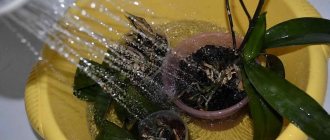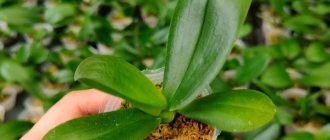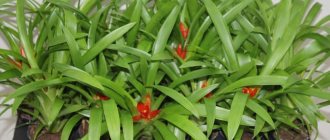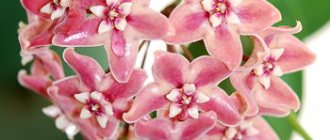Do you have an orchid growing, but you don’t know how to replant it at home? Read the article, it contains a lot of useful tips and instructions.
The orchid, just like the rose, can be called the queen of flowers. Graceful flowers, decorative leaves, intertwining roots and stems create a plant of incredible beauty. But this flower, like all the others, needs good care, an important component of which is replanting. It needs to be done correctly and on time - the further development of the plant and the abundance of flowering, as well as the duration of the adaptation process, depend on this.
Read another article on our website that tells how to propagate an orchid at home with children, cuttings, roots, and seeds. All methods are described in detail.
This article describes the timing, as well as the rules for transplanting a home orchid. You will learn how to replant a flower after the store and why to do it at all. Read on.
Why replant an orchid when grown at home: is it replanted at all, is it possible?
Orchid transplantation at home
Various circumstances may arise under which a transplant is performed. Why replant an orchid when growing it at home? Is it possible to replant at all? Yes, this can and should be done. Here are the circumstances under which flower breeding experts advise doing this:
- Replanting is required once every 3-4 years after purchasing or replanting the plant.
- If it is noticed that the roots have begun to appear from the pot, i.e. it has become too small for the plant.
- If the orchid is very sick, all its leaves begin to turn yellow.
- Unsightly appearance and condition of the substrate in which the flower grows. Mold or severe dryness of the upper fragments has appeared on the surface, which indicates a loss of the filler’s ability to pass water and air.
- The plant does not bloom for several years, and then it needs a good shake-up in the form of a transplant.
- If necessary, divide the orchid.
If these signs are not observed, it is better not to touch the orchid - it does not really like to be disturbed. It is also not recommended to do this during the flowering process; it is better to wait until it is over, unless an urgent transplant is needed.
Orchid transplantation - how to understand that it is necessary?
It is known that the orchid as a plant belongs to the class of epiphytes. This type of plant grows in close intertwining with various tree crops. Thus, the orchid roots intertwine the tree bark and receive the necessary beneficial microelements and moisture. However, this process occurs in the flower’s natural habitat, and at home, the soil is periodically depleted, and the flower stops feeding properly. That is why it is necessary to transplant it and do it as correctly as possible.
As a rule, the substrate for the normal development and growth of a home orchid is a special soil mixed with the bark of coniferous trees. This soil promotes normal air circulation throughout the pot. Over time, after constant watering, the soil becomes compacted and dries out more slowly; the roots of the plant begin to receive less oxygen, which leads to their gradual rotting.
In addition to oxygen, for the normal development of a plant such as an orchid, it is necessary to comply with the acid-salt parameters of the soil. Therefore, experienced gardeners recommend using special water for watering the plant with the addition of acidic elements, for example, citric acid, or fertilizing the soil with peat, then you can use ordinary water. At the same time, due to a constant excess of salts and acidic elements, the soil is quickly depleted, which, along with a lack of oxygen, leads to depletion or complete drying of the roots.
Based on the above, orchids must be replanted every 2-3 years. However, sometimes this needs to be done more often, it all depends on the specific growing conditions. Experts recommend immediately transplanting a flower if signs of the disease are detected, such as:
- decomposition or drying out of the soil;
- the roots of the plant have rotted or become shriveled;
- the leaves are covered with yellow spots;
- there is no normal flowering (more than three months);
The listed symptoms indicate the need to replant the plant, otherwise it will die. In addition to these signs, others may also appear, such as overgrowth of leaves, a significant increase in plant weight, or the appearance of various pests (scale insects, nematodes, etc.). It is best to replant an orchid in the spring and always after flowering. Thus, the flower quickly adapts to new conditions and soil. Transplanting during flowering is fraught with unpleasant consequences; the flower simply will not take root.
Timing: when can an orchid be replanted?
Replanting an orchid at home
This operation should be carried out when the dormant period of the inflorescences and the entire plant has ended. But there are types of orchids in which the dormant period is weakly expressed, for example, phalaenopsis, which blooms almost all year round with short breaks. Therefore, if new shoots of a plant do not develop in the absence of signs of disease, it means that it is entering a dormant period. This is the best time to replant. This time usually occurs in the spring - late February and March. This is the best time to replant an orchid.
Features of transplantation
After the purchase
A plant should be replanted after purchase only if it dies. Otherwise, if the substrate is good, then there is no need to replant. If the bark has collapsed, it is replanted under the following conditions:
- after flowering;
- after the plants have acclimatized in your apartment (about 2 weeks).
in spring
The best period for transplantation is spring, when daylight hours increase (late February-early March). The transplant technology is standard.
In a glass vase
Quite an unusual way of planting and cultivating orchids. The positive side of this is that the plant hardly needs to be watered. In the sense that with the correct selection and placement of substrate components, moisture from the bottom of the vase gradually rises up and flows to the roots. Under such conditions, the root system can reach relatively large sizes and resemble a beard.
It should be understood that this method requires some experience and knowledge, the volume of which is worthy of a separate article and will not fit into a small paragraph.
Old orchid
Old plants are replanted in the same way as young or mature ones. The only caveat is that with a particularly large plant you need to be more careful than with small, young ones. Old, well-cared for orchids usually have a bushy root beard that is easily damaged. You need to be careful with them. Otherwise, the transplantation technology is identical to specimens of other ages.
Once the transplantation process has been completed, install the orchid in a shaded place where the temperature will be 22-25 degrees.
Frequency of orchid transplantation at home: how often?
Replanting an orchid at home
Many novice flower lovers ask the question: “How often to replant an orchid?” . What determines the frequency of transplanting inflorescences at home?
- The answer to this question depends on what composition of the substrate is in the container.
- It may consist of moss, and then it needs to be replanted more often - once every two years .
- If the main part of the substrate is bark, which decomposes more slowly, then you can replant it once every three years.
Of course, these dates are indicated for planned replantings, when the inflorescence looks completely healthy and has no signs of damage by insects.
Rules for choosing soil
Nowadays, soil for orchids can always be purchased in specialized stores. Substrates are offered from both Russian and foreign manufacturers, but in all cases you must carefully study the description of the compositions.
The soil must be loose and of high quality, so if a hardened piece is offered in a bag, it is better to refuse it.
The packaging must contain a detailed description of the composition listing all components. It is also obligatory to note that this substrate is intended for epiphytic orchids.
The composition should not contain dust or moldy pieces. The substrates are based on crushed bark (size 2-3 cm), charcoal, fiber, and fern roots. If the finished soil still contains many small fragments, it is recommended to carefully sift the composition through a coarse sieve.
Substrate for orchid transplantation at home: what is it made of?
Substrate for transplanting orchids at home
To transplant orchids at home, you need to choose a high-quality substrate. The health and further flowering process of the plant largely depends on this. What is it made of? You can buy a specialized one at retail outlets, but it comes in two types:
- For epiphytic (i.e. with aerial roots). It's called Phalaenopsis Mixture.
- For terrestrials - “Mixture for Cymbidium”.
The first mixture is used for flowers growing on trees with long aerial roots. Therefore, the substrate for them must be breathable, because the roots of these flowers take part in photosynthesis and they do not need soil, only moisture, to grow. The composition of such mixtures usually includes:
- Pine bark
- Ground fern root
- Activated carbon
- Cut cork
- Sphagnum in small quantities
The second type of mixture is denser, because it is intended for orchids living on the ground. It contains more of these ingredients:
- Sphagnum moss
- Lowland peat
- Leaf ground
- Coal
Sometimes various synthetic materials, such as perlite or foam, are used as a substrate. You can also use:
- Expanded clay
- Shell rock
- Pumice
The substrate can be made at home. Pine bark is used for this:
- First disinfect it - hold it over steam for half an hour or boil it in water.
- After this, dry and boil again. This treatment kills all pathogenic organisms.
- Place to dry again and then cut into pieces up to 2 cm .
To the bark prepared in this way, add dry and finely chopped sphagnum moss and just a little peat coal. You can now fill the pots with this mixture.
What can I use for the substrate?
Osmunda fern roots
The unique composition of fern makes it an ideal substrate component. It contains almost all the nutritional elements for an orchid.
Perlite
Natural material of volcanic origin. Free from impurities. Does not harm plants. Capable of collecting moisture and expending it in doses. Used as an addition to the substrate.
Humus
Leaf humus is added in small doses. Its main danger is the content of pathogenic microorganisms and insects. Before adding it to the substrate, it must be disinfected.
Pine cones
They are used, having previously been divided into flakes, as an additive to the main substrate. Whole buds are inconvenient due to their ability to open and close with changes in humidity.
Natural cork fiber
Rare material. Typically used as a replacement for coconut fiber or moss.
Activated carbon
Disinfectant. Crushed tablets are sprinkled over the cut areas and thus combat problems in the root system. This is a common situation during plant transplantation.
Charcoal
It is often added to the composition, but not more than 5% of the total mass. Has the following beneficial properties:
- improves water and air permeability of the substrate;
- prevents acidification, increases pH;
- natural antiseptic;
- prevents the soil from becoming waterlogged;
- prevents the development of putrefactive processes;
- absorbs harmful substances.
Over time, charcoal accumulates a lot of salts, which can negatively affect the plant. It is necessary to take proven coal. It is best to burn birch logs yourself, and take the coals as a component of the substrate.
Sphagnum moss
Common substrate component. It absorbs moisture from the air well and contains a lot of nutrients that are missing in the bark. The minimal microflora of moss does not allow the development of pathogenic bacteria.
Vermiculite
Its main advantage is the regulation of air-water balance. It absorbs more moisture than its own volume. Prevents drying out and clumping. Contains a sufficient amount of useful microelements. Prevents salinity and acidity.
Styrofoam
Used as drainage and as an element of stability. Good air permeability.
Expanded clay
With the help of pores, it retains not only moisture, but also salts contained in water for irrigation. Over time, their quantity accumulates, the substrate becomes saline, and expanded clay ceases to accumulate moisture. Another disadvantage is that it draws moisture from the roots when it dries out.
Coconut fiber
Absorbs moisture well and regulates soil moisture. An organic component that has some characteristics superior to peat. Does not cake and does not form lumps. Good air permeability.
Peat
Absorbs and retains nutrients. It has good moisture capacity and at the same time is able to hold a large amount of air. The main disadvantage is that it increases acidity. It must be neutralized with other components if peat is used.
Oak bark
Distributes moisture evenly and retains air. Contains many nutrients. Requires heat treatment before use to neutralize tanning properties.
Pine bark
The most common substrate component. It has all the properties so necessary for orchids - uniform distribution of moisture and ensures maximum air flow. Before use, it is necessary to carry out heat treatment to neutralize harmful insects and resins.
It is harvested by removing the bark from a healthy fallen tree in a pine forest. The material must be dry, without signs of pests. The bark should be easily peeled off the trunk using your hands.
Which pot is best to replant a home orchid?
It is better to replant the orchid in a transparent pot.
Most orchids have large roots that like to entwine the pot from the inside and even look out. Therefore, when choosing a new container for a flower, you need to focus primarily on the size of the root system. But, given that the base of the flower will grow further, you need to add a few centimeters to the diameter. Which pot is best to replant a home orchid?
Worth knowing: For a large orchid with intensive growth, you can buy a pot, as they say, “for growth,” so as not to replant it often.
Orchid lovers most often grow their “beauties” in plastic transparent pots or containers. What are the advantages of such containers? Here is the answer:
- The roots are clearly visible and you can constantly monitor their condition. With normal soil moisture, the roots are usually green, but as the substrate dries, they gradually turn gray, which indicates the need for watering.
- In plastic containers, unlike clay ones, the roots do not grow to the walls of the container and therefore are not injured during replanting.
Although clay containers have their advantages:
- In them, the base-root does not overheat, which is very important for orchids.
- Do not overwater the plant because the moisture will last longer.
- In addition, a clay pot is much heavier than a plastic one and therefore will not tip over. Orchids are planted in such pots, some of the roots of which completely dry out and die during the dormant period.
Be sure to make drainage holes in the containers. This will provide the roots with faster drying and ventilation, which will protect them from rotting. Flower lovers with no experience often overwater the plant for fear of drying it out. Drainage holes will help in this case too.
Worth knowing: Plastic containers have one drawback - they have a rather simple, not very sophisticated appearance, compared to the flower itself. To correct this shortcoming, you can buy a beautiful flowerpot that will completely hide the plastic.
There is another way out - you can put a plastic pot in a low glass vase. The space between the walls of the vase and the pot is filled with some kind of jewelry or tinsel, balls or floral fillers. This needs to be done carefully so that the multi-colored filler does not distract from the beauty of the orchid flowers.
Remember: Do not buy large containers for orchids. In small ones - up to 15 cm in diameter, it feels much better and blooms longer.
List of ready-made substrates
Making a substrate for orchids with your own hands is a troublesome task. It is much easier to buy soil for Phalaenopsis orchids, the composition of which is specially selected for a specific type of plant. Today in the retail chain you can purchase various substrates for planting phalaenopsis. Let's look at some popular brands.
“Kekkila” is a universal substrate for all epiphytic species of orchids, has the following composition:
- A mixture of coniferous and deciduous tree bark;
- Charcoal;
- Expanded clay.
The substrate contains humic acids. These substances have a beneficial effect on the development of the root system and the general condition of the plant. The soil has good moisture capacity and breathability, as well as a uniform structure.
"Fasco" is the optimal composition for growing many types of orchids. The soil undergoes thorough treatment against fungi and pests and is completely ready for use.
“Fasco” includes the following materials:
- Tree bark;
- Charcoal;
- High peat;
- Expanded clay.
The composition of the soil for phalaenopsis provides optimal conditions for the growth and development of orchids.
"Geoliа" is a universal soil substrate suitable for all epiphytic plant species, has the following composition:
- Shredded pine bark;
- Dry sphagnum moss;
- Charcoal.
The soil has sufficient moisture capacity. It is treated against parasites and does not contain weed seeds or soil particles. This is a universal substrate, completely ready for use.
"Ceramis" is a substrate based on modern inorganic materials. It consists of granules made from clay of a special composition. Their porous structure allows the plant to provide the necessary moisture and nutrition. Substrate composition:
- Pine bark – 70%;
- Clay granules – 30%.
The substrate has optimal moisture holding capacity due to the use of porous clay. Clay granules are also capable of absorbing fertilizers so that they can be released to the plant during the next watering. Which soil is best for the Phalaenopsis orchid, watch the video:
How to transplant children, one child, a shoot of a home orchid: step-by-step instructions
Replanting a baby home orchid
An orchid growing in normal, ideal conditions can produce young shoots, or babies. This is a great opportunity to propagate the plant. What should be done? How to transplant children, one child, a shoot of a home orchid? Here are the instructions step by step:
- The baby should have fairly long roots - more than 5 cm and 3-4 leaves - these are the most suitable parameters for transplantation.
- Children usually appear on the stem or near the root collar. Using a sharp knife, you need to cut off part of the stem with the baby, stepping back to the sides at a distance of about 1 cm . Sprinkle the cut area with coal.
- Prepare a small glass in advance, preferably a plastic one, and add a small layer of drainage.
- Place the baby in a glass and carefully cover it with substrate. for the first 3-4 days .
- Place the glass with the baby in a place where the air humidity is high. You can simply spray the surface of the window sill where the glass is located more often. Try not to get it on the leaves.
The baby will grow in such a container for about a year, after which it can be transplanted into a larger container. An orchid grown from a child will bloom in three years .
DIY substrate for phalaenopsis orchids
Phalaenopsis are not such whimsical and capricious orchids; it is no coincidence that they are most often grown in apartments. But this does not mean that any soil will suit them. What compositions can you make yourself?
- Take charcoal and oak bark (proportion 1:5) and mix. This soil is suitable for phalaenopsis growing in flowerpots. “Plus” of the composition: it does not accumulate moisture, which is destructive for this type of orchid, and provides excellent air circulation.
- Another common composition: tree bark, white sphagnum moss, birch charcoal (ratio 5:2:1). This soil is used in pots, various baskets, and blocks.
- In rooms with higher humidity levels, a different substrate is used: bark (preferably pine or larch), polystyrene foam, cork tree bark (proportion 4: 3: 2).
- Sometimes the soil for phalaenopsis is made only of pebbles, expanded clay (as drainage) and gravel. But this composition is good only for the summer period, since in winter the orchid roots can be cool. Therefore, it is still advisable to add crushed bark to such a substrate.
- When growing phalaenopsis on a block (for example, a piece of bark), a small amount of moss is also used, which is fixed to the block. Then they carefully attach the plant, cover its roots with moss, secure it, and the composition is ready. Usually, on such blocks, orchids grow with their leaves down or to the side, that is, exactly the same as in natural conditions.
Instead of bark, it is convenient to use sheets of foam plastic for the block (especially young phalaenopsis).
Further proper care of the phalaenopsis orchid plant after transplantation, growing conditions
After replanting, you need to provide proper and timely further care for the orchid. Here are the conditions for growing a phalaenopsis orchid plant:
Proper care of an orchid is to shade the window so that the sun does not burn the leaves of the flower.
- As mentioned above, immediately after the transplantation is made, the container is placed on a sunny windowsill for a week, but shaded from direct sunlight. Otherwise, if this is not done, the orchid leaves will lose their decorative appearance, wrinkle and become wilted.
You can water the flower after transplanting only after a couple of weeks.
- water the plant after replanting only after 2 weeks . The fact is that orchid roots are susceptible to various fungal diseases. Therefore, the root system needs to be slightly dried to avoid this. Find out how to properly water an orchid here .
Spraying the plant so as not to dry it out
- But, in order not to dry out the plant, spray the leaves, or, even better, wipe them with a wet sponge. In this case, under no circumstances should water get into the depths of the rosette of leaves. This can lead to their rotting.
Orchid grows at optimal temperature
- It is important to maintain optimal temperature. The orchid does not like heat, it needs a temperature no higher than +21-22°C , but it should not fall below 18°C . Otherwise, the inflorescences get stressed, which is very undesirable for these sissies.
Feed the orchid
- A blooming orchid needs feeding. Use only mineral mixtures. Organic ones are not suitable for feeding flowers, since they can introduce diseases into the soil.
Excessive nitrogen nutrition can cause leaf growth to the detriment of flowering. Nowadays you can find special fertilizer compounds for orchids in stores. In any case, it will be good to use an all-purpose fertilizer for flowering plants. They must be diluted strictly according to the instructions so as not to harm the flower. They need to be added along with water for irrigation.
What soil composition is needed for a phalaenopsis orchid?
It must be emphasized that phalaenopsis cannot be planted in a substrate where there is soil. If you come across such a mixture in a store, then draw the right conclusions and do not purchase any more products from this brand.
The situation, however, is quite possible to improve. Simply pour the contents of the bag into a bucket of water and use only the ingredients that float to the top.
The soil intended for phalaenopsis varies in composition. However, the main ingredient is almost always pine bark. Strictly speaking, it is not an ideal solution, but it is excellent for growing representatives of the Orchid family at home. The material, on the one hand, ensures uniform distribution of water, and on the other, allows air to penetrate to the roots.
If you collected the bark yourself, be sure to sterilize it by boiling. This will kill pests, bacteria and reduce resin content. It is important to get rid of the latter, as it greatly reduces moisture capacity.
Oak bark is used a little less frequently. Its properties fully correspond to those of pine. But tannins can create a problem here. They can also be removed by boiling.
Peat is taken from the top. Its advantage is high moisture capacity. The component adsorbs nutrients and gradually releases them to the orchid. The disadvantage of the material is high acidity. The indicator is normalized by mixing dolomite flour (1 tbsp per kg).
Coconut fiber is used as a substitute for peat and sphagnum moss. It does not cake, absorbs water well, and does not interfere with air circulation. It is mainly taken when phalaenopsis is planted in blocks.
Vermiculite loosens the soil mixture and slows it down:
- drying out;
- compaction;
- salinization
Sphagnum moss is uniquely hygroscopic. It is able to absorb moisture even from the air, which is very valuable for phalaenopsis. It is also a supplier of a number of useful minerals.
Charcoal is mixed into substrates in limited quantities (no more than 5%). Its purpose is to enhance air permeability and moisture capacity. There is another advantage - antiseptic properties.
Pine cones are sometimes recommended for use as a substrate, but this should only be done in extreme cases. The problem is that they contain a lot of resin, which cannot be removed by boiling.
Important: humus or leaf soil can be placed in the soil for phalaenopsis, but in very small quantities. They must be steamed first.
To grow a healthy orchid, you will also need drainage. Most often used:
- expanded clay;
- Styrofoam;
- small crushed stone;
- broken ceramics.
These components are placed strictly on the bottom of the pot, but sometimes some of them are included in the substrate.
If there is no flowering after transplantation: what to do?
Lack of flowering after transplantation
After transplantation, the orchid should increase its green mass and bloom after a certain time. This usually happens after 3-4 months . But what if the inflorescences do not appear for much longer? What to do if there is no flowering after transplantation? This problem can occur for several reasons:
- The plant is overfed with nitrogen fertilizers , active leaf growth is observed, they become larger than they should be during normal development. In this case, feeding should be stopped for a month.
- The transplant was not carried out in a timely manner . For example, if for some reason an orchid was transplanted at the time when it bloomed last year, then it most likely will not bloom this year. The plant will direct all its energy to restoring its root system, and not to flowering.
- Perhaps you made mistakes during transplantation . If the plant is not firmly fixed in the substrate, then when you move the pot, it begins to dangle in it, and the roots and stems will receive microtrauma. The plant does not have the opportunity to direct its energy to flowering, experiencing constant stress.
- Insufficient lighting and low humidity . You need to move the pot to a lighter windowsill and spray its surface to increase the humidity of the surrounding air.
Follow these tips, and your flower will soon delight you with its unique blooms. It's worse when the plant begins to wilt. What to do? Read on.
Popular substrate compositions
In addition to the above compositions, there are also soils for orchids with a predominance of stones and rocks. Phalaenopsis grows well in soil made from the following components:
- Pine bark – 2 parts;
- Gravel or pebbles - 2 parts;
- Expanded clay – 1 part;
- Charcoal – 1 part.
The following composition can also be used:
- Pine or oak bark - 3 parts;
- Pieces of pumice – 1 part;
- Charcoal – 1 part;
- Fern roots – 1 part;
- Expanded clay – 1 part.
This substrate has increased moisture capacity. It can be used to keep plants at low air humidity.
There are also mixtures with synthetic materials. Most often, pieces of foam are used to loosen the soil. Here is one of the popular compositions for phalaenopsis orchids, which includes polystyrene foam:
- Pine bark or coconut chips – 2 parts;
- Crushed cork tree bark - 2 parts;
- Expanded clay – 1 part;
- Charcoal – 1 part;
- Pieces of polystyrene foam – 1 part.
Of the purchased substrates, Seramis has proven itself to be excellent. This soil does not contain any plant components. It is a clay granulate that holds water well. Orchids planted in Seramis intensively increase their leaf mass and bloom profusely, and problematic specimens are quickly restored.
Today, some gardeners recommend growing phalaenopsis in hydrogel. Plants planted in hydrogel look very attractive. But it should be remembered that this material is not intended for growing orchids.
Phalaenopsis planted in hydrogel live no more than a year and then die.
What to do if your home orchid withers after transplantation?
A home orchid withers after transplantation.
Most likely the plant is sick. If planting rules are violated, when mechanical damage to the roots occurs, the leaves do not receive full nutrition. What to do if your home orchid withers after transplantation? Here are the tips:
If you watered a lot, replant the plant:
- With good watering and stagnation of liquid at the bottom of the container, especially if there is no drainage, the roots may begin to rot.
- Then the wilting will soon be replaced by yellowing of the leaves and the plant may die.
- Here an emergency orchid transplant will be needed to save it.
Control pests:
- Another reason could be a pest attack.
- Spider mites, the worst pests of indoor plants, thrive in dry air.
- It can be difficult to notice them right away - they are very small and the bad effects begin to appear when there are a lot of them.
- Whiteflies and scale insects also harm orchids. Providing optimal air humidity will help to significantly reduce the number of these insects.
Protect from the sun:
- If the orchid is not protected from direct sunlight, its leaves will begin to wilt.
- This indoor flower feels best on windows that face east, where the sun appears only in the morning and for a short time.
Containers must be provided with drainage holes, and they need to be made not only at the very bottom of the container, but also on the sides to ensure good air exchange for the roots.
Lighting and temperature conditions
These factors partly depend on the type of flower. But not a single orchid can tolerate direct sunlight. Therefore, pots need to be shaded during peak solar activity. But with all this, the lighting should be quite bright. Typically, in the summer, plants are placed on the east side of the house. And in winter they are illuminated with lamps.
The optimal temperature is 18-22 ⁰С. In winter, it is recommended to reduce it by a couple of degrees. Also, if possible, a daily temperature difference should be ensured - usually the night mode is 4-5 ⁰C colder than the daytime.
How to properly water a home orchid flower?
Well-groomed orchid flowers
Watering a home orchid flower is carried out by immersion in water, the temperature of which is not lower than +20°C , so as not to cause stress to the plant. How to do this correctly? Here is the answer:
- To do this, take a cup with warm liquid and place the container with the plant in it for 20 minutes .
- Then take it out and place it on a wire rack to drain off excess water.
- Then place the flower in its usual place.
In winter, the number of waterings should be reduced, but in summer, on the contrary, this should be done more often, at least twice a week. It is necessary to monitor the pseudobulb - if it has lost turgor, then watering is necessary.
Important: It is forbidden to take long breaks between waterings. The orchid is a tropical plant that naturally lives in times of frequent rain and high humidity. Therefore, drought is detrimental to it.
How to replant an orchid flower if the root is rotten: tips
Replanting an orchid flower if the root has rotted
Infrequently, but there are cases when novice gardeners, as a result of improper care, have the roots of an orchid rot. This can happen to all the roots or to a large part of them at once. Is it possible to save the plant then? How to replant an orchid flower if the root is rotten? Here are the tips:
- To revive orchids whose roots have completely died, you need a small window greenhouse.
- In the container where the leaf rosette will be located, you need to pour a small layer of drainage - this can be expanded clay or pebbles.
- Place sphagnum moss on top, which is previously kept over steam and dried.
- Now moisten the substrate and place the leaf rosette in it.
- Transfer to a greenhouse, where a constant temperature should be maintained within +21 - +27°C and high humidity of about 100% . The light should be bright, but diffused - direct sunlight is detrimental to leaves during this period.
After 3-4 weeks of this regime, root rudiments will begin to appear at the base of the leaf rosette and then they will begin to grow. Epin , to the water for irrigation .
If a diseased orchid has several living roots left, or even just one, the chances of saving it increase:
- After trimming the rotten roots, you need to rinse the remaining living roots under warm water and sprinkle the cut areas with charcoal.
- A pre-prepared pot up to 8 cm in diameter is filled with ordinary substrate and a leaf rosette with roots is planted in it.
- Next, the plant is treated as in the first case, placing it in a greenhouse.
If everything went well, new roots will begin to grow in 2-4 weeks .
Is it possible to replant a flowering orchid while it is blooming?
You can replant orchids during flowering, but in the most urgent cases.
There is only one situation in which you can replant a blooming orchid - if it is in danger of dying for any reason and you need to choose one of two:
- The orchid will fade, but then die, having spent its last energy on flowering.
- The peduncle is cut short, but later with good care, the plant is completely restored and after a while it will bloom again.
What to do in the second case? Adviсe:
- Prepare fresh substrate and pot. How to do this has already been said above in the text.
- Cut the flower stalks of the orchid to about 2/3 of the length. By the way, the flowers can be placed in water - they will last for almost a week.
- Carefully remove the plant from the pot and inspect the roots, cutting out any rotten ones.
- If the substrate is in normal condition, i.e. there is no mold or its smell, it is not overdried or, on the contrary, very waterlogged, then in this case you need to try to preserve it as much as possible without shaking off the roots. Otherwise, proceed as with a regular transplant, the procedure of which has already been described.
- Now you need to place the plant in the pot and secure it well there.
All that remains is to put the orchid, transplanted during flowering, into the greenhouse and observe how it will feel further. Do not forget to follow all the rules for caring for this flower, which are no more complicated than the rules for caring for other indoor flowers.
Soil requirements
The soil for the phalaenopsis orchid is not soil in the usual sense of the word. In nature, this plant takes all its nutrients not from the soil, but from the water that washes its roots during the rains. Therefore, when kept indoors, soil is needed mainly to support and hold the plant in the pot. It must provide:
- Air permeability;
- Moisture permeability;
- Drying in 3-4 days:
- Nutrient retention.
Compliance with the requirements will ensure air access to the roots of the plant and prevent stagnation of moisture . All this will make it possible to bring the indoor conditions of keeping the orchid closer to natural ones.
An important requirement for soil is its ability to retain nutrients. In the wild, the orchid feeds on substances washed off the tree bark by rain streams.
Indoor maintenance requires regular feeding of the plant with specialized fertilizers. They must be held in the soil so that the orchid can consume them when watered.
Another important point in choosing soil for phalaenopsis is its coarse fractionation. The substrate should not cake and contain fine particles and dust.
Not only air and water pass through large fragments of the substrate, but also light. This is very important for the development of phalaenopsis, since photosynthesis processes take place in its roots, as well as in its leaves.











